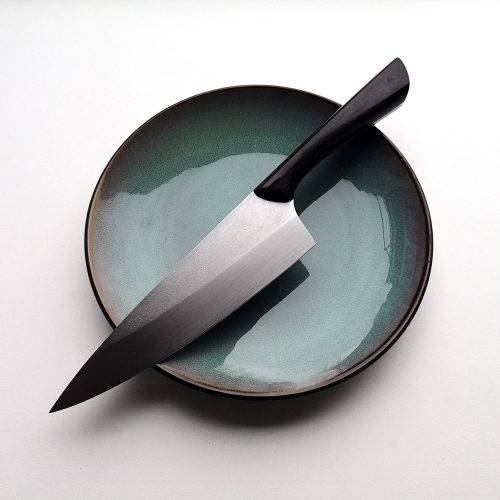Description
This Santoku Holland knife is a token of appreciation to our homeland.
The vertical spacers in the handle refer to the colours of our patriotic flag; orange, white and blue. The usual colours of the Dutch flag are red, white and blue—there’s no orange at all. But the Dutch population closely identifies with orange. They wear it on days of national pride, and their sports teams’ uniforms are almost all a bright orange hue. The reason why orange is such a prominent color in the Netherlands is that it used to be part of our flag, red was orange. Also, our royal family’s last name is ‘van Oranje Nassau’. The flag color changed over time but our royal family are still called ‘the oranges’
Santoku knife
A Santoku is a medium-sized, multipurpose kitchen knife of Japanese origin that has a lightweight blade with a straight or slightly curved cutting edge and a spine that curves downward to the tip. The Santoku has long been the Japanese equivalent of a chef’s knife. Compared with a classic chef’s knife, the Santoku is typically shorter and has a thinner blade, a stubbier tip, and a straighter edge.
Roman Oak
The Roman Oak which we use for the handle of this knife is a story on it’s own…
This wood has been used by the Romans to make water wells around 2000 years ago! It has recently been discovered in Veldhoven, a village in the south of the Netherlands. During archaeological excavations over 40 wells were found, ranging from the Iron Age, to the Roman era and the Middle Ages. Through our connections we were lucky enough to get our hands on some beautiful pieces of this Roman Oak. Over time the wood has totally become black from being in the acidic ground for so long.
Carbon Steel
Our blades of carbon steel are made from discarded circular saw blades. While stainless steel is the most common material for kitchen knives, carbon steel is often the preferred choice of culinary professionals. That’s because a carbon steel blade, when properly cared for, holds a sharp edge for a long time.
Because there is a relatively large amount of carbon in the steel, the blade is very hard, but therefore not stainless. This means that the knife discolours quickly, especially when fruit acids are involved, for example. Depending on what you have cut, you can find different shades of grey on the blade. This is also called patina and is nothing to worry about. The patina partly ensures that the knife is less susceptible to rust in the long term. The knife will never become rust-free, which is why good maintenance is important.











